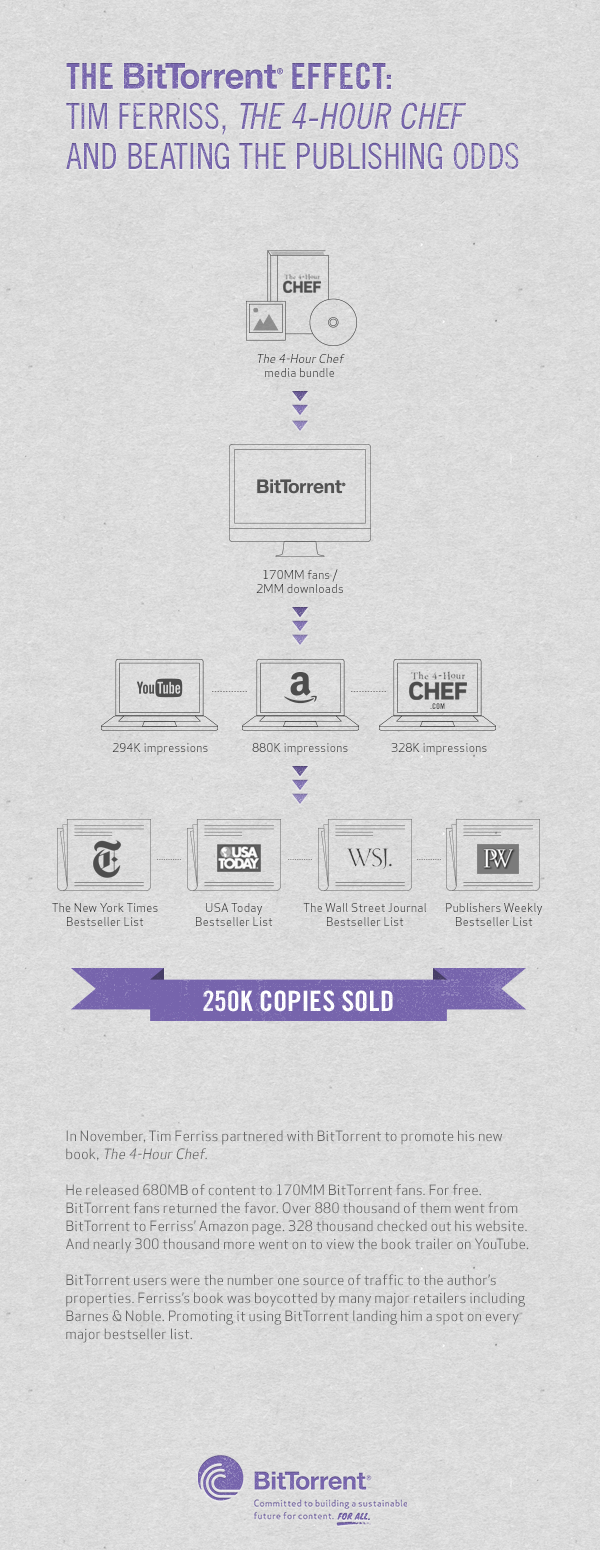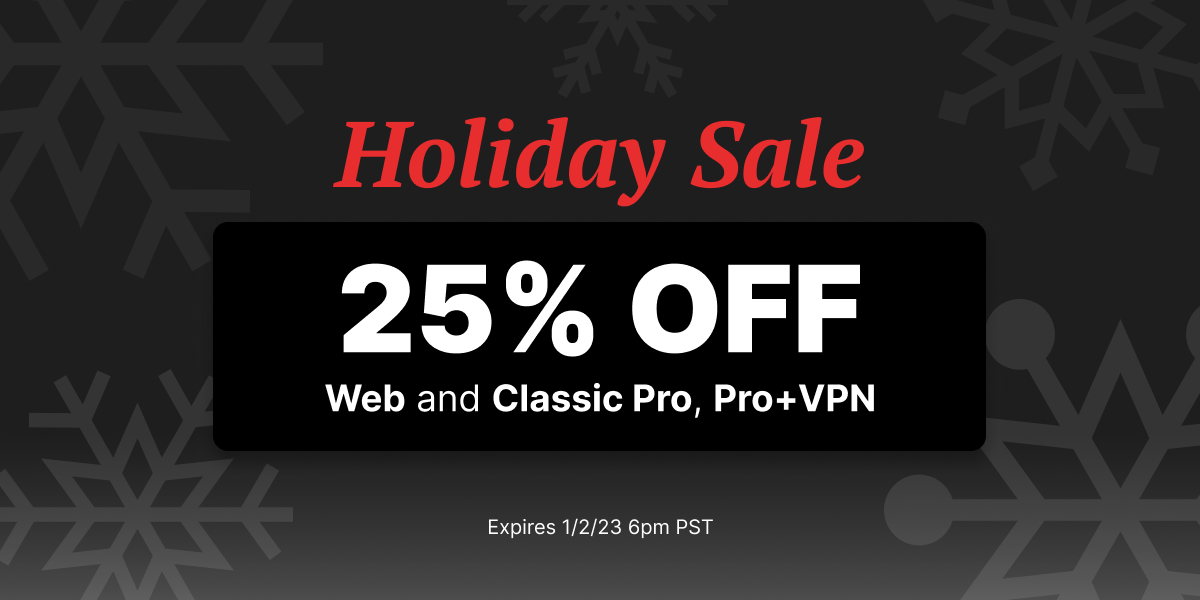Your Book Is A Startup: Tim Ferriss, The 4-Hour Chef, And The BitTorrent Publishing Model
If you’re a writer, here’s what you’re up against. No other industry has as many new product introductions as the publishing sector. No. Other. Industry. And your industry is in decline.
Adult nonfiction books peaked in 2007, and have fallen each year since then. Bookstores are selling less books. In fact, average book sales are incredibly small. The typical US nonfiction book sells fewer than 250 copies per year, and under 3,000 copies in its lifetime. Think you’ll see your next book on shelves? Good luck. Because each new book has less than 1% chance of being stocked in an average bookstore.
Now, imagine your book has been boycotted by Barnes & Noble. Now you’re in Tim Ferriss’ shoes.
The author’s latest installment in The 4-Hour series was available on Amazon, but not in stock on major retailer shelves. Ferriss’ The 4-Hour Chef essentially had no physical footprint. How then, did his book go from boycotted to the best-seller lists, winning a Gourmand Cookbook Award along the way?
Simple. He stopped marketing The 4-Hour Chef as a book. Instead, he marketed it as a startup; relying on an iterative release schedule and spreadable, targeted content. Ferriss let usage drive product upsell, and users drive book seeding and distribution. He built in mechanisms for reward and social echo throughout the promotional cycle, mobilizing potential readers to act. Here’s how you hack publishing in sixty days or less.
Publishing in bites, bits, and targeted iterations.
Tim Ferriss’s The 4-Hour Chef was designed to be a reference book; a big, encyclopedic guide to the skill of meta-learning. With a page count of 672, it looks…well, it looks intimidating. For a super-fan, for a self-help academic, for someone with a lot of time. Not for everyone, maybe.
Maybe, not.
In fact, the book was built to be shared. Ferriss designed each chapter and section to be self-contained. There are infographics and recipe cards. The 4-Hour Chef, and titles like it, resemble albums more than they do books. They’re epic thematics broken down into 3-minute tracks.
This book-as-album strategy gives authors like Ferriss a significant advantage. Releasing chapters as singles creates a continuous news cycle during pre-launch promotion. It effectively creates radio play; increasing the chances that you’ll get heard with sample content. At the same time, it provides the flexibility to micro-target: using different chapters to reach and activate different readers. Ferriss used the book’s lessons in restaurant-cool to talk to the fashion kids at Refinery29, adventures in hunting to talk to MeatEater, and performance diet secrets to talk to the UFC crowd. It’s easier to mobilize micro-collectives of readers than it is to move one big mainstream bloc.
Publishing the process amplifies this effect. Everything that didn’t make the cut – in Ferriss’s case, over 255 pages of material – is an asset. By distributing making-of-videos, photos, interviews, rough drafts, and cut sections, authors can build momentum and context for their release. People share the remarkable, arresting, and idiosyncratic. An author’s process is all of these things.
Letting usage drive upsell.
If you want everyone to read your book, let everyone read your book. Placing content within the BitTorrent ecosystem has the effect of sampling, radio play, or TV advertising. It’s just at infinite scale.
To promote The 4-Hour Chef, Ferriss released the first chapter of his book, in addition to 680MB of behind-the-scenes content on BitTorrent. This content was downloaded by over 2 million people, who in turn:
Clicked on to the book’s trailer YouTube: 293,936 people
Clicked on to the author’s website: 327,555 people
Clicked on to the book’s Amazon page: 880,009 people
BitTorrent users accounted for 20% of the book trailer’s total YouTube views. BitTorrent users were also the single largest bloc of visitors to the book’s website (Source: bit.ly). BitTorrent helped the book sell over 250,000 copies, earning it a place on every major bestseller list.
Inviting readers to seed and distribute content.
Within the BitTorrent ecosystem, the people who consume content also distribute content. Your download is simultaneously uploaded, so others can use it. In theory, it sounds complicated. IRL: it’s not. Shut out by Barnes & Noble, Ferriss used super-fans as distribution centers. People who liked the book could open their own storefronts for The 4-Hour Chef via Rally.org. Ferriss committed a $6 donation for each fan book sold, and top sellers were rewarded with prizes and all-expenses-paid travel.
Building relationships with readers, before and beyond the sales transaction.
This notion – the idea of a value exchange between authors and fans beyond the book transaction – is a critical part of 2.0 book promotion. Ferriss rewarded fans early, measurably, and often.
The author ran six promotions over the course of 60 days. Booksellers were offered the opportunity to travel with the author. Winning YouTube remixers were given 60 minute phone calls. Audio-book recommenders were given first reads. Bulk purchasers were given subscriptions to the author’s favorite products, as well as exclusive interview transcripts and notes from The 4-Hour Chef. The rewards were personal. Competitions weren’t about closing sales, but instead about interacting with fans.
For many authors; for many of us – traditional publishing approaches will not work. We might not be able to get into Barnes & Noble. We might not have marketing budgets, or a massive fan base.
We might be able to make it.
We can build books for sharing. We can sample at scale. We can give readers a stake in distribution. We can open up exchange between artist and fan, beyond the sales transaction. And we can do this in a way that drives creative profitability. Ferriss’s experiment with distributed, startup style publishing proves there’s more than one option for authors looking to hack bestseller lists.




